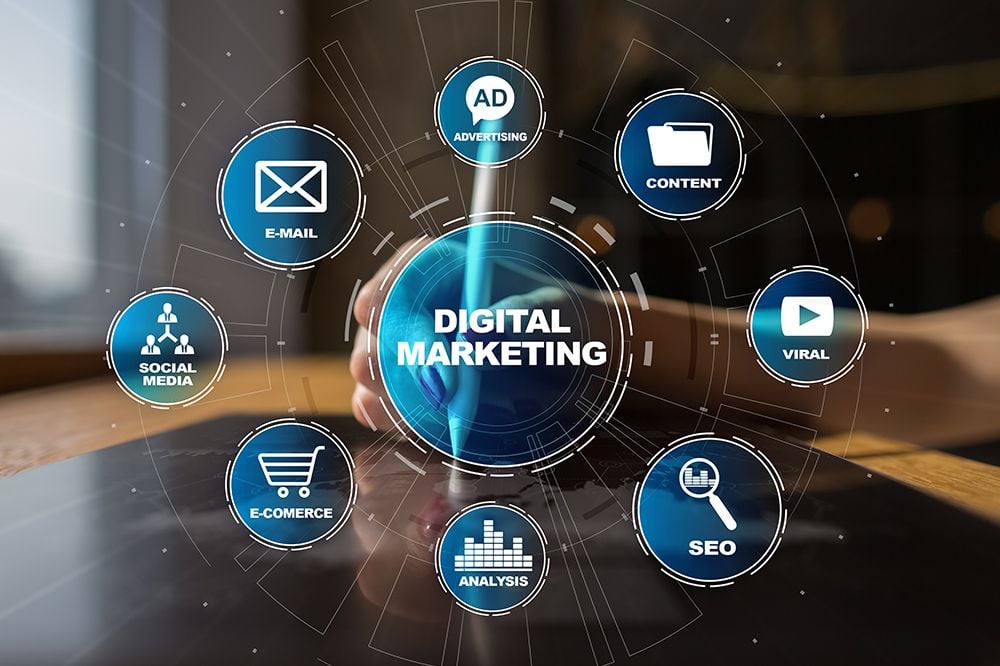Digital Marketing
In today’s interconnected world, digital marketing has become an indispensable tool for businesses to reach their target audience and drive growth. With the rise of the internet and technology, the way businesses connect with customers and promote their products or services has drastically transformed. Digital marketing encompasses a wide range of strategies and channels, enabling businesses to engage, interact, and influence their audience like never before. In this article, we will explore the concept of digital marketing and highlight its key components and benefits.
What is Digital Marketing?
Digital marketing refers to the use of digital channels, platforms, and strategies to promote products, services, or brands to a targeted audience. It leverages various online channels such as search engines, social media, email, content marketing, and paid advertising to create awareness, generate leads, drive traffic, and ultimately convert prospects into customers.
Key Components of Digital Marketing:
- Search Engine Optimization (SEO): SEO is the practice of optimizing websites to rank higher in search engine results pages (SERPs). By improving a website’s visibility and organic search rankings, businesses can attract more organic traffic, increase brand awareness, and drive relevant leads. SEO techniques include keyword research, on-page optimization, link building, and technical optimizations to enhance website performance.
- Pay-Per-Click Advertising (PPC): PPC advertising enables businesses to display targeted ads on search engine results pages, social media platforms, and other websites. Advertisers only pay when a user clicks on their ad. This model allows businesses to reach a highly specific audience, control their ad spend, and track the performance of their campaigns in real-time.
- Social Media Marketing: Social media has revolutionized the way businesses connect with their audience. Social media marketing involves creating and sharing content on social media platforms such as Facebook, Instagram, Twitter, LinkedIn, and YouTube. It helps businesses build brand awareness, engage with customers, drive website traffic, and generate leads. Social media marketing also involves paid advertising on social media platforms to reach a wider audience.
- Content Marketing: Content marketing focuses on creating and distributing valuable, relevant, and consistent content to attract and retain a specific target audience. It includes blog posts, articles, videos, infographics, ebooks, and more. Content marketing helps businesses establish thought leadership, educate their audience, build trust, and drive organic traffic to their website.
- Email Marketing: Email marketing involves sending targeted messages and promotional content to a subscriber list. It is an effective way to nurture leads, build customer relationships, and drive conversions. Email marketing campaigns can include newsletters, product updates, special offers, and personalized messages to engage and retain customers.
- Influencer Marketing: Influencer marketing leverages the popularity and influence of social media personalities and content creators to promote products or services. Influencers have established credibility and a loyal following in specific niches. Collaborating with influencers allows businesses to reach their target audience through authentic and influential voices.
Benefits of Digital Marketing:
- Wider Reach: Digital marketing enables businesses to reach a global audience. With the internet’s ubiquity, geographic barriers are no longer a hindrance, allowing businesses to connect with customers around the world.
- Targeted Approach: Digital marketing allows businesses to precisely target their ideal audience based on demographics, interests, and behaviors. This targeting capability helps maximize the return on investment by focusing efforts on the most relevant audience segments.
- Cost-Effectiveness: Compared to traditional marketing methods, digital marketing is often more cost-effective. Channels like social media and email marketing allow businesses to reach a large audience at a fraction of the cost of traditional advertising methods.
- Measurable Results: Digital marketing provides extensive analytics and tracking capabilities. Businesses can measure the performance of their campaigns in real-time, track key metrics, and gain insights into their audience’s behavior. This data-driven approach helps optimize strategies and achieve better results over time.
- Improved Customer Engagement: Digital marketing enables businesses to engage and interact with their customers on various platforms. This two-way communication fosters relationships, builds trust, and creates a personalized experience, enhancing customer satisfaction and loyalty.
Inbound marketing vs digital marketing
Inbound marketing and digital marketing are two distinct approaches to promoting products or services. Digital marketing encompasses a wide range of strategies and channels, including SEO, PPC, social media, email, and more. It focuses on reaching and engaging with the target audience through online platforms. In contrast, inbound marketing is a methodology that aims to attract and engage potential customers through valuable content, personalized experiences, and building long-term relationships. While digital marketing is a broader term encompassing various online tactics, inbound marketing emphasizes creating meaningful connections and providing value to customers, ultimately leading to conversions and customer loyalty.
B2B & B2C digital marketing
B2B (Business-to-Business) and B2C (Business-to-Consumer) digital marketing are two distinct approaches tailored to target different types of audiences and achieve specific business objectives. Let’s delve into the key differences between B2B and B2C digital marketing.
B2B Digital Marketing: B2B digital marketing focuses on promoting products or services to other businesses. It aims to build relationships, generate leads, and drive conversions that lead to long-term partnerships. B2B digital marketing strategies often include content marketing, search engine optimization (SEO), email marketing, social media marketing, and account-based marketing (ABM). The decision-making process in B2B transactions tends to be more complex, involving multiple stakeholders. B2B marketing emphasizes providing educational content, demonstrating expertise, and addressing pain points specific to the target business.
B2C Digital Marketing: B2C digital marketing, on the other hand, targets individual consumers. It aims to create brand awareness, drive sales, and foster customer loyalty. B2C digital marketing strategies often revolve around social media marketing, influencer marketing, search engine marketing (SEM), content marketing, and email marketing. B2C marketing emphasizes emotional appeal, creating engaging and visually appealing content, and utilizing storytelling techniques to connect with consumers on a personal level.
While both B2B and B2C digital marketing share some common strategies, such as content marketing and social media marketing, the focus and approach differ significantly. B2B marketing tends to be more targeted and relationship-driven, while B2C marketing often relies on appealing to emotions and making direct purchase appeals.
Understanding the nuances between B2B and B2C digital marketing is essential for businesses to tailor their strategies and messages effectively, catering to the specific needs, behaviors, and decision-making processes of their target audience.
How to create a digital marketing strategy
Creating a digital marketing strategy involves several key steps. First, clearly define your objectives and target audience. Conduct market research to understand customer preferences and behavior. Set measurable goals and identify the most effective digital channels to reach your audience. Develop a content strategy that aligns with your goals and resonates with your target audience. Implement SEO techniques to improve your website’s visibility. Utilize social media, email marketing, paid advertising, and other tactics to engage and convert customers. Regularly track and analyze data to measure the success of your strategy and make necessary adjustments. Continuously refine and optimize your digital marketing efforts to achieve long-term success.
Conclusion
Digital marketing has transformed the way businesses connect with their audience and promote their offerings. With its diverse range of channels and strategies, digital marketing empowers businesses to reach their target audience with precision, engage customers effectively, and drive growth. By embracing the digital landscape and leveraging the power of digital marketing, businesses can unlock new opportunities, increase brand visibility, and stay ahead in today’s competitive marketplace.





